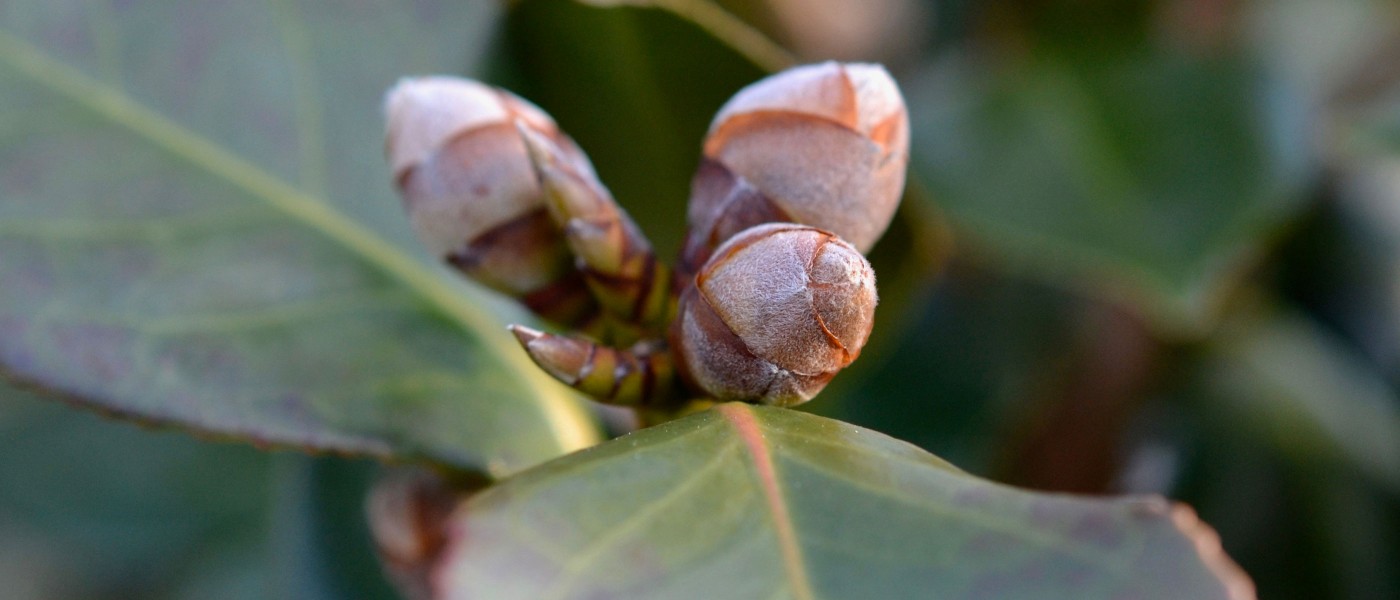Get to Know These Buds
What is a bud? A bud is a flower that has not bloomed yet or a leaf that will soon unfurl. Winter buds hold all the potential of spring in small, gift-wrapped packages. But instead of lying at the foot of a tree like presents before Christmas, they perch all along the tree's branches and stems and sometimes even directly on the trunk or roots.
During winter, leaves and flowers of many plants rest dormant as buds under protective scales, waiting for their cues to emerge. Sometimes the scales are covered in fine hairs for extra protection. Some buds are “naked,” meaning they have no scales. When buds are found at the end of a branch, they're called terminal buds. When found at leaf axils, they're called axillary buds. Some buds appear on other parts of a plant, like the roots or trunk.
Look closely to see the variety of shapes, sizes, colors, and textures of buds. These small gifts of the garden will delight you during each visit. Here are just a few of my favorites here at Brooklyn Botanic Garden.
Persian Ironwood(Parrotia persica)
North of the Rock Garden
These petite flower buds look like little chocolate chips dotting the ironwood's branches. Woolly and brown, they are quite simply adorable. They aren’t as obvious as some of the larger buds on the list, so you’ll have look closely to observe them. In late winter—my favorite time to look at them—these dark buds begin to crack open slowly, offering tantalizing peeks at the bright-red flowers soon to emerge.
Often overshadowed by its famous neighbor, the Caucasian wingnut, the ironwood tree, which also has exfoliating bark for additional winter interest, is a splendid example of this species and well worth seeking out.
Paperbush(Edgeworthia chrysantha)
Washington Avenue Shade Border
This shrub’s downy, golden-gray buds hang in tight clusters from its bare branches. Lacking scales, these buds are naked, but they do have fine hairs to protect them. The hairs also give the buds a wonderful shimmery quality so that they sparkle in the winter sun. There are nice paperbush specimens in the Discovery Garden, on Lily Pool Terrace, in the Shakespeare Garden, and near the Flatbush gate, but my favorite one is just south of the Garden’s administrative entrance at 1000 Washington Avenue.
Leatherleaf Mahonia(Mahonia bealei)
Fragrance Garden
These Medusa-like clusters of purple stems and chartreuse buds provide a splash of color in winter. The buds form a raceme, which simply means that the buds hang from short stems (also called pedicils) along a central stem. As spring approaches, the buds continue to swell and turn ever more yellow until they finally open in a sunshiny burst of fragrant flowers.
Various Magnolias(Magnolia species and cultivars)
Magnolia Plaza
Magnolias are lovely in winter, thanks to their smooth, gray bark and large, distinctive buds. Like many early-spring-blooming woody plants, magnolias have fuzzy bud scales to help insulate and protect the developing flower right up until it blooms. In many species, this happens as early as March. Their soft fur varies in color, sometimes dark, sometimes light, sometimes greenish gray.
Japanese Pieris(Pieris japonica ‘Valley Rose’)
Rock Garden
This shrub is showier in bud than some plants in full bloom. The buds are so rich in color that people often mistake them for berries. Like the mahonia, these buds are clusters of racemes. They hang gracefully in long clusters and contrast nicely with the dark green evergreen foliage.
Weeping Beech(Fagus sylvatica ‘Pendula’)
Oak Circle
A popular tree when it’s fully leafed out, the weeping beech is just as beautiful with bare branches, when its elegant, weeping habit is even more striking. Beeches have distinctive, sharply pointed buds with smooth, overlapping scales and an almost metallic, lancelike appearance. Once you become familiar with them, you’ll be able to easily identify beech trees in the winter.
Winter-Hazel(Corylopsis pauciflora)
Discovery Garden
The fat, rosy buds of the winter-hazel perch along the branches like beads on a string. The buds of this shrub are among my favorite buds to watch as they gradually swell with the warming weather and lengthening days. Some buds foreshadow the shape and color of the flowers to come, but not these. Their compact shape and reddish color belie the appearance of feathery yellow early-spring blooms.
Common Camellia(Camellia japonica 'Jerry Hill')
Discovery Garden
The exquisitely overlapping scales of this shrub’s buds almost look like flowers. The slightly smaller leaf buds sit close to the flower buds and are slimmer and more pointed. These contrasting types of buds form a little bud bouquet.
Weeping Pussy Willow(Salix caprea 'Kilmarnock')
Rock Garden
All the willows at the Garden have lovely buds, especially the weeping pussy willow ‘Kilmarnock’. The pendulous branches of this dwarf cultivar drape over the boulders in the Rock Garden, putting the buds at perfect viewing height. As spring approaches, the flowers start to emerge, half in, half out, the fluffy white of the flowers contrasting with the smooth, reddish bud scales.
Pinkster Azalea(Rhododendron periclyminoides)
Water Garden
Rhododendron and azalea buds show an astonishing variety of form, color, and texture. The bud scales of this species have a distinctive reddish hue at the base and a slate-gray color at the tips, an arrangement that seems to presage the new life emerging from beneath the gray of winter.
More: What Are Pussy Willows, Anyway?
This is just an introduction to the beautiful buds beginning to swell all over the Garden. There are also wonderful dogwoods, viburnums, and buckeyes, to name just a few! Anytime in the winter is a good time to observe buds as they patiently await spring, but my favorite time is mid- to late winter, when they start to emerge and expand. Buds are beautiful in their own right, but knowing they signal the coming spring just enhances their appeal.


